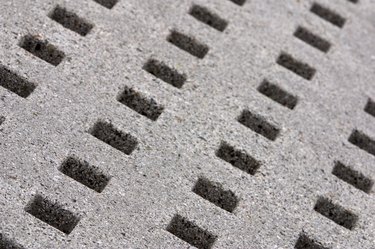
Concrete is a versatile material used to build a wide range of structures, including skyscrapers, dams, bridges, highways and sidewalks. It's composed of portland cement, aggregate, and water. Portland cement is a mixture of raw materials combined to create certain chemical conditions. There are eight different kinds of portland cement manufactured according to different physical and chemical requirements for the variety of structures built with concrete.
Raw Materials
Video of the Day
Portland cement is a combination of calcium, silicon, aluminum, and iron, and smaller amounts of other materials; the chemicals are obtained from limestone, shells or chalk, and shale, clay, sand or iron ore. The raw materials are proportioned to meet specifications for the eight types of Portland cement described in the American Society for Testing and Materials Specification C-150. Portland cement usually makes up about 10 to 15 percent of the concrete mix.
Video of the Day
Properties of Concrete
Concrete is a mixture of paste and aggregates. The paste, composed of portland cement and water, coats the surface of coarse and fine aggregate. The chemistry of portland cement is activated by water; in a process called hydration, the paste hardens and gains strength. Concrete has two opposing qualities: it's easy to easy to work with when first mixed, and hardens into a strong and durable material. These qualities make it essential to the built environment.
Types of Portland Cement - I and II
Type I portland cement, from the ATSM Designation C-150, is a general purpose cement for structures where the special characteristics of the other types aren't required. Type I is used for sidewalks, reinforced concrete buildings, bridges and water and sewer infrastructure. Type II is formulated to resist moderate sulfate attack, especially for structures near groundwater that contains sulfate. Type II hydrates more slowly and with less heat than Type I. It's used for piers, abutments and heavy retaining walls.
Types III to V
Type III portland cement is a high-early-strength concrete; it sets in a week or less. It's used where the structure must be completed quickly, or to reduce curing time in cold weather. Type IV is a low heat of hydration cement, used for massive concrete structures, such as gravity dams, where heat isn't released from the mass. Type V portland cement is for concrete near soils and water with severe and very severe concentrations of sulfate.
Types IA, IIA and IIIA
Types I, II, and III have corresponding air-entraining specifications to increase their resistance to freeze-thaw action. Their composition is the same as the specific type, with small amounts of air-entraining materials ground into the cement during manufacturing to produce evenly and well-distributed minute air bubbles.